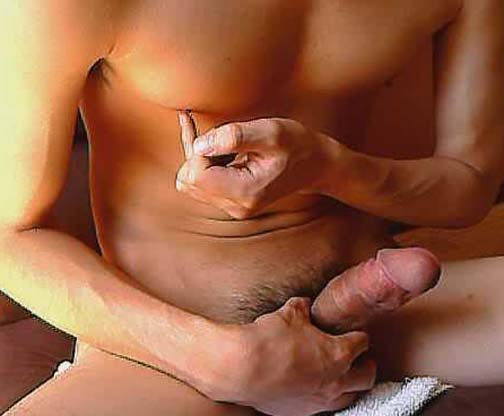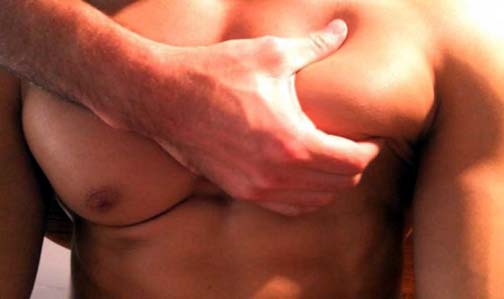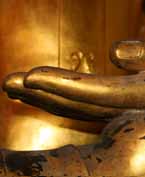
Thanks to its sexpat population, Buddhas in Pattaya display a mudra seldom seen outside of the area.
Today in Thailand is Makha Bucha Day, a Buddhist holy day that farang celebrate by whining about not be able to buy enough booze to get them through ’til tomorrow. Most Thais, however, ignore the sexpats crawling through the gutters and head for the closest wat to pay their respect to the Buddha. Those whose religious fever over cheap booze and even cheaper boys was instrumental in their deciding to call Thailand home on the other hand, often claim that if you’ve seen one wat you’ve seen them all, a convenient excuse to not spend time away from their favorite boy bar, and an excuse they seldom use to dispense with that same familiarity they have with a bottle of gin.
But as the more enlightened and sober folk know, every wat is unique unto itself. And every Buddha is different. Every Buddha is special, and every Buddha’s hands tell a story. Known as mudras, the position of the Buddha’s hands reference either an important occasion in his life, or one of the principle Buddhist virtues. And since virtues are one of the things lacking among the sexpat population, learning more about some of the better known mudras may help lead to enlightenment. Or at least temporary sobriety. Time spent at a local temple would be the obvious manner to gain this knowledge, but for the sexpat indulging in one of his favorite pastimes – offing a bar boy – can be equally educational as like the Buddha moneyboys often display these meaningful hand gestures too.
Occasionally referred to as throwing Buddhist gang signs, each traditional mudra has a specific meaning. And each imparts a message that, when properly understood, may help cause a sexpat to drop to his knees in reverent worship. Thusly, an explanation of the more common mudras your boy du jour may display seemed like an appropriate post for Makha Bucha Day:
The Dhyana, or Samadhi mudra, is the hand gesture that promotes energy and a cleansing of all impurities, in which the delusion of attachment becomes the wisdom of discernment with the extended finger representing the ‘solitary realizers’. When your boy du jour throws the Dhyana mudra he is reminding you that from past experience he has learned he can earn just as large of a tip by chuck-wowing you as by actually performing those sexual acts you had your heart set on.
The Vitarka mudra is the hand gesture that evokes the energy of intellectual discussion, or argument. Knowing sexpats as he does, your boy du jour realizes in your case that just means arguments. But like all Thais he will avoid confrontation at all costs. Regardless of what that ends up costing you. This mudra comes in handy for him as it allows for a transmission of a particular teaching with no words. Especially if he has just arrived in Pattaya and has not yet learned how to say iPhone. You can interpret it to mean: if you want this, you’ll buy me . . .
The Hridaya mudra may prove very helpful to release pent-up emotions and unburden your heart. It is symbolic of bringing together two aspects of enlightenment, wisdom and method – meaning your boy du jour is wise to your methods. It’s a promise that he will help you release your pent-up energy flow, provided you unburden his heart by demonstrating you are not a cheap bastard and will tip him what he’ll pretend he is worth.
The Varada mudra expresses the energy of compassion, liberation, and an offering of acceptance. This mudra is also called a boon-granting mudra, because it helps bestow a specific quality of energy one might be seeking from another. This mudra expresses further the rarefied and powerful energy emanating from an enlightened being through his or her hands. Or wallet. Initially it appears to be a natural gesture – probably used from prehistoric times as a sign of good intentions – that proposes friendship, or at least peace; since antiquity, it was also a gesture asserting power. As such it is your boy du jour’s reminder to you that it is in his power to make your dreams and wishes come true, provided there is taxi money involved on top of his tip.
Typically translated as the Mudra of Unshakable Self Confidence, this hand gesture evokes so much more. Or so much less depending on which side of the bedroom you’re standing in. It is the hand gesture that evokes greeting another being with the utmost respect and adoration for the Divine in all bar boys. It is also called warding off the evil and is one of the more popular mudras thrown by bar boys while a potential customer decides whether or not to off him. Easy to interpret in any language, it means you can look, but not touch. Unless you are willing to tip him first.
| Related Posts You Might Enjoy: | ||








